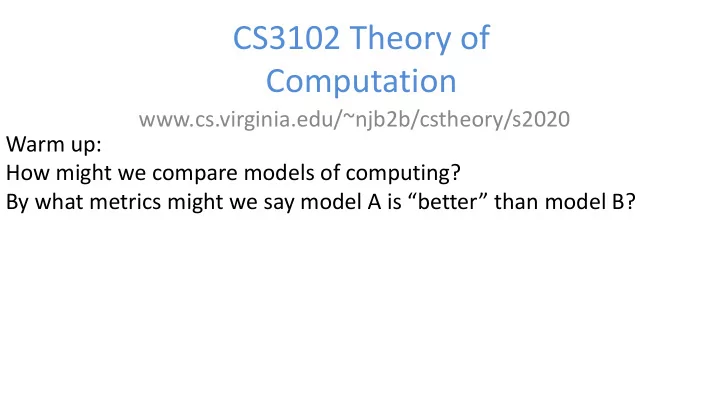

CS3102 Theory of Computation www.cs.virginia.edu/~njb2b/cstheory/s2020 Warm up: How might we compare models of computing? By what metrics might we say model A is “better” than model B?
Logistics • Exercise 0 was due last week – Didn’t complete it? No problem (this time)! Just do it soon. Ask for an extension on the assignment page. • First Quiz was due today – Didn’t complete it? No problem (this time)! Ask for an extension on the assignment page. • Exercise 1 is out. 2
Last Time • Boolean Circuits as a model of computing • Components: – Inputs (how many?) – Gates (how many?) – Outputs (how many?) • Important: Each circuit receives an input of a fixed size – Function of form 0,1 𝑜 → 0,1 𝑛 for 𝑜 inputs and 𝑛 outputs – What is the size of the domain? 3
Defining the AON circuit model • Define how to represent a computation – And/Or/Not circuit: • Number of inputs • Number of outputs • Gates and their labels • Wires connecting the above • Define how to perform an execution – For each component, find its value once all its inputs are defined – Inputs start of with their value defined – Things labelled as output are the result 4
NAND with AON • Build a circuit for 𝑂𝐵𝑂𝐸 Input Output 00 1 – 𝑂𝐵𝑂𝐸 𝑏, 𝑐 = ¬(𝑏 ∧ 𝑐) 01 1 10 1 11 0 = 5
Today • Comparing models of computing – And/Or/Not circuits vs NAND circuits – Circuits vs languages 6
= NAND Circuits • The set of functions we can compute with 𝑂𝐵𝑂𝐸 gates only is the same as the set of functions we can compute with circuits 𝐵𝑂𝐸 , 𝑃𝑆 , 𝑂𝑃𝑈 gates. – These computing models are “equivalent” • How do we show this? 7
Equivalence of Computing Models Computing Model 𝐵 and Computing Model 𝐶 are • “equivalent” if they compute the same set of functions 𝐵 – Any function that can be implemented with 𝐵 can also be implemented with 𝐶 , and vice-versa • To show: – How to take an implementation of 𝐵 and convert it into an implementation of 𝐶 (which computes the same function) – How to take an implementation of 𝐶 and convert it into an 𝐶 implementation of 𝐵 (which computes the same function) 8
AND/OR/NOT using NAND • 𝐵𝑂𝐸 • 𝑃𝑆 • 𝑂𝑃𝑈 9
NAND = AON NAND to AON AON to NAND Everywhere Everywhere you see: you see: Instead put: Instead put: NOT NOT 10 NOT OR
Majority using NAND 𝑏 5 gates 𝑐 𝑧 𝑑 𝑏 24 gates 𝑧 𝑐 𝑑 11
Takeaway • We now have a hardware-based model of computing to work with – Actually two! • Meant to be similar to how CPUs operate • We’ve already made proofs about models of computation! • While some models are equivalent in what they can compute, they may not be in how efficiently they can do it • Next time: a software-like model of computing 12
A circuit-like programming language • Define how to represent a computation – Inputs as positional arguments – Outputs as return statements – Variable assignments using boolean operators AND/OR/NOT • Define how to perform an execution – Evaluate each variable assignment sequentially AON-Straightline 13
MAJ with our language • English: – Return 1 if at least 2 inputs are 1, 0 otherwise • Math: – 𝑁𝐵𝐾 𝑏, 𝑐, 𝑑 = 𝑏 ∧ 𝑐 ∨ 𝑏 ∧ 𝑑 ∨ (𝑐 ∧ 𝑑) • AON-CIRC: 14
With your neighbors 𝑂𝐵𝑂𝐸 Input Output • Write AON-straightline programs: 00 1 01 1 – 𝑂𝐵𝑂𝐸 𝑏, 𝑐 10 1 11 0 𝑌𝑃𝑆 Input Output – 𝑌𝑃𝑆(𝑏, 𝑐) 00 0 01 1 10 1 11 0 15
With your neighbors 𝑂𝐵𝑂𝐸 Input Output • Write AON-straightline programs: 00 1 01 1 – 𝑂𝐵𝑂𝐸 𝑏, 𝑐 10 1 11 0 𝑌𝑃𝑆 Input Output – 𝑌𝑃𝑆(𝑏, 𝑐) 00 0 01 1 10 1 11 0 16
AON-Straightline = NAND-Straightline • Show any function I can implement in the AON-Straightline language can be implemented such that the only operation is NAND 17
NAND Straightline = AON Straightline NAND -> AON AON -> NAND 18
NAND Straightline = AON Straightline NAND -> AON AON -> NAND x = NOT(a) x = NAND(a,b) x = OR(a,b ) Becomes Becomes Becomes x= NAND(a,a) temp = AND(a,b) t1 = NAND(a,a) x = NOT(temp) t2 = NAND(b,b) x = AND(a,b) x= NAND(t1,t2) Becomes temp= NAND(a,b) x=NAND(temp,temp) 19
Circuits equivalent to AON Straightline • How do we show this? 20
Convert Expression of each into the other • NAND-Straightline Components – Inputs as positional arguments – Outputs as return statements – Variable assignments using boolean operator NAND • NAND-Circuit Components – Number of inputs – Number of outputs – Gates and their labels – Wires connecting the above 21
Circuit to Straightline • Inputs as positional arguments – Come from: • Outputs as return statements – Come from: • Variable assignments using boolean operator NAND – Come from: 22
Circuit to Straightline 23
Straightline to Circuit • Number of inputs – Come from: • Number of outputs – Come from: • Gates and their labels – Come from: • Wires connecting the above – Come from: 24
Straightline to Circuit 25
Recommend
More recommend